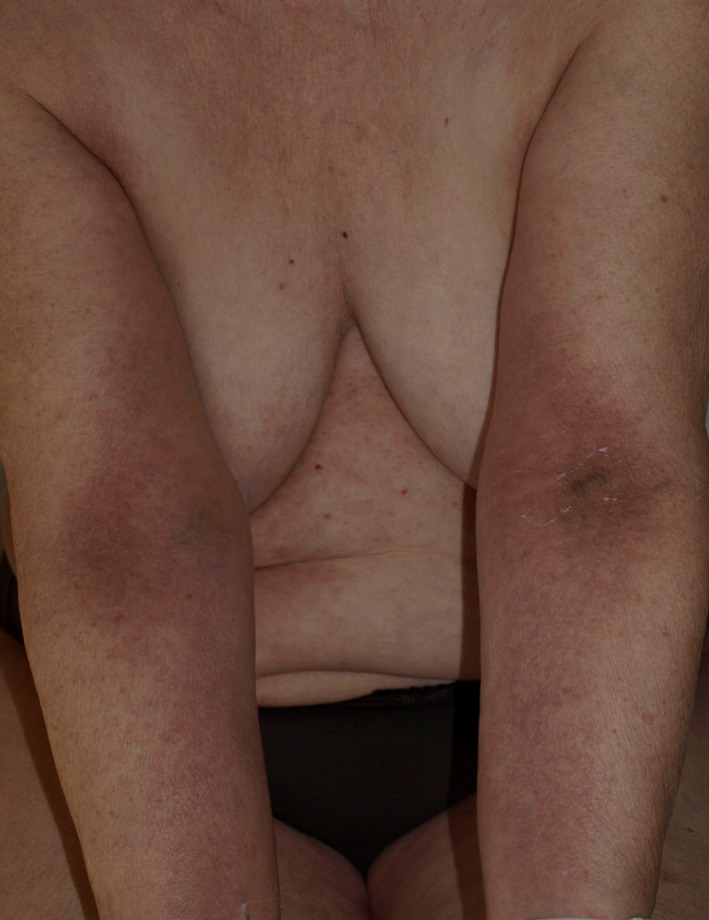To the Editor
A skin rash has been reported in 2 out of 1.099 patients presenting with coronavirus disease 2019 in China, 1 as in 14 of 48 patients with the same disease in Italia, but unfortunately without further description of its semiology. 2 We wish to report here the case of a woman who presented, coincidently with COVID‐19, a skin rash that had an original picture.
A 64‐year‐old woman with type 2 diabetes presented with fever (up to 40 °C) and asthenia, for which she began to take oral paracetamol. Four days later, an erythematous rash began on both antecubital fossa (Fig. 1), that extended during the following days on the trunk and axillary folds (Fig. 2); fever persisted, and a cough appeared. A chest CT showed bilateral interstitial abnormalities. A RT‐PCR test on a nasopharyngeal swab specimen was positive for SARS‐CoV‐2 ARN. There was no suspicion of systemically applied contact allergen. The rash disappeared five days after its beginning (at day 9 of the disease), while fever persisted until day 16, a period during which the patient repeatedly took paracetamol. All symptoms finally resolved at day 18.
Figure 1.

Erythematous rash on antecubital fossa.
Figure 2.

Erythematous rash on trunk, including axillary fold.
The rash described here appeared to us reminiscent of symmetrical drug‐related intertriginous and flexural exanthema (SDRIFE), a condition that has been regularly reported in association with the intake of certain drugs, but also more rarely in association with a viral infection, such as primary parvovirus B19 infection. 3 , 4 The role of paracetamol could also be discussed here but, in addition to the fact that paracetamol has been only exceptionally reported as a cause of SDRIFE, 5 the rash disappeared despite the continuation of the drug, an unusual occurrence in drug reactions.
In conclusion, we wish to draw the attention of clinicians on a skin rash with a subtle but rather distinctive picture that, although skin symptoms seem unusual during COVID‐19, may have a diagnostic utility if other similar observations happen to be reported.
Acknowledgements
The patient in this manuscript has given written informed consent to the publication of her case details.
References
- 1. Guan W, Ni Z, Hu Y et al. Clinical characteristics of coronavirus disease 19 in China. N Engl J Med 2020; 382: 1708–1720. 10.1056/NEJMoa2002032 [DOI] [PMC free article] [PubMed] [Google Scholar]
- 2. Recalcati S. Cutaneous manifestations in COVID‐19: a first perspective. J Eur Acad Dermatol Venereol 2020. 10.1111/jdv.16387. [Epub ahead of print]. [DOI] [PubMed] [Google Scholar]
- 3. Dubois A, Thellier S, Wierzbicka‐Hainaut E, Pierre F, Anyfantakis V, Guillet G. Exanthème à type de “syndrome babouin” au cours d’une primo‐infection par le parvovirus B19: deux cas. Ann Dermatol Venereol 2010; 137: 709–712. [DOI] [PubMed] [Google Scholar]
- 4. Yamada Y, Isawa A, Kuroki M, Yoshida M, Itoh M. Human parvovirus B19 infection showing follicular purpuric papules with a baboo syndrome‐like distribution. Br J Dermatol 2004; 150: 788–789. [DOI] [PubMed] [Google Scholar]
- 5. Megna M, Cinelli E, Napolitano M, Fabbrocini G, Patruno C. Paracetamol‐induced symmetrical drug‐related intertriginous and flexural exanthema (SDRIFE) in a psoriasis patient receiving apremilast therapy. Contact Dermatitis 2019; 81: 451–454. [DOI] [PubMed] [Google Scholar]


